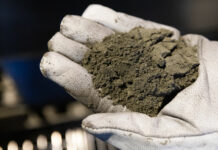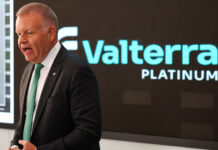
NORTHAM Platinum CEO, Paul Dunne, gave his strongest signal yet the firm was ready to resume dividend payments, saying today that not even capital growth plans doubling annual PGM production to one million ounces by about 2025 would make a serious dent on its anticipated cash flow generation.
“Potentially the best decade ever,” is how Dunne described PGM supply and demand fundamentals currently. In addition to supply deficits for palladium and rhodium, he pointed to a structural deficit in iridium that had seen its price increase to $3,500/oz from $1,500/oz in a year, and the possibility of a similar price appreciation for ruthenium, a metal Northam produces most after platinum and palladium.
Much vaunted electric vehicle penetration in the gasoline market – deemed an existential threat to PGMs less than a decade ago – would be 15% of total growth to 120 million units in the next five years, he said. “The internal combustion engine has a long way to go,” Dunne. Automakers had to make “clean cars” owing to emission regulations and they could make them with PGMs “used properly”, he said.
Dunne’s comments came in response to analyst and media questions following Northam’s interim results presentation today in which headline earnings were up nearly three-quarters. Cash generation totalled R3.1bn in the six months, leaving net debt at a still considerable R8.8bn as of December 31.
However, net debt would be “well below current levels” by year-end whilst over the next three years the company was positioned to average R35bn in cash generation, assuming the current price appreciation of rhodium, in particular, held steady. This was far more than Northam could deploy in growth, said Dunne who hastened to say he was providing an illustrative, “back of the matchbox” calculation, not guidance.
Nonetheless, Dunne’s bullishness was for all to hear, and boded well for the reinstatement of the dividend, especially as the company nears the conclusion of the preference share repurchase programme of its Zambezi Platinum empowerment vehicle. The year-end net debt number includes over R6.9bn in Zambezi Platinum preference share repurchases and the repayment of its revolving credit facility, followed in the second half by R1.1bn additional preference shares repurchases.
With 87% of Zambezi Platinum now owned by Northam, the stage is set for the complete redemption of the structure’s liabilities. Dunne declined to comment further on what may be announced following the issue of several cautionary statements, or the imminence of a transaction, indicating only that the deal may pave the way for clarity on further returns to shareholders.
Dunne’s market optimism is the polar opposite of the caution expressed earlier this month by Royal Bafokeng Platinum (RBPlat) CFO, Hanré Rossouw, who likened project spending in the current PGM market to drunken enthusiasm at a commodity cocktail party. Undeterred, Dunne said in response to one analyst question that Northam’s three mines/projects – Zondereinde, Booysendal (and Booysendal South), and Eland Platinum – were replete with optionality and could support yet further production growth beyond a million oz.
“We will double production by the middle of the decade … We are also considering our next phase of growth,” he said, adding that: “I think we can look forward to improved returns”.
Shares in Northam Platinum are 342% higher over the last 12 months, and at a market value of R120bn, the company is unrecognisable to the single, lease-bound asset entity of 2014 when Dunne was appointed.











